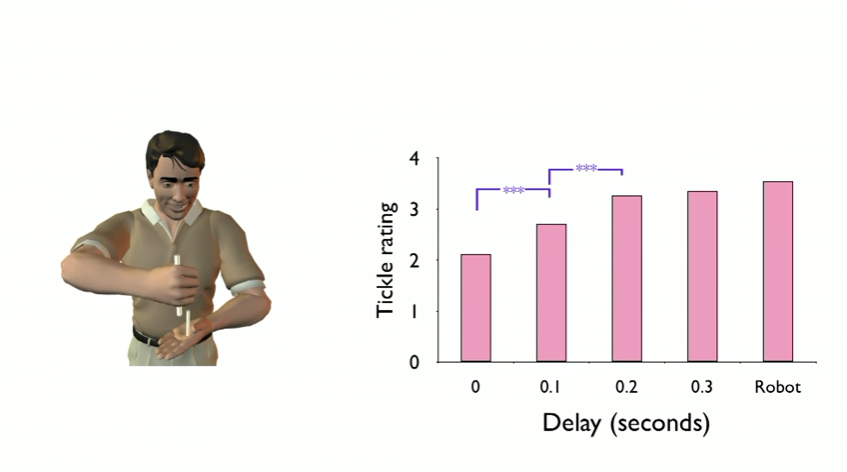What evidence is there for this?
那有什么证据支持这点吗?
Well there's one very clear example where a sensation generated by myself feels very different then if generated by another person.
我们认为其中一个非常明了的例子就是自身产生的动作带来的感觉与他人做同样动作带来的感觉是十分不同的。
And so we decided the most obvious place to start was with tickling.
我们认为最直接的着手点就是挠痒痒这件事。
It's been known for a long time, you can't tickle yourself as well as other people can.
众所周知,人们挠自己的时候总是不如别人挠自己的时候痒。
But it hasn't really been shown, it's because you have a neural simulator, simulating your own body and subtracting off that sense.
但是没有被证明为什么,其实是因为每个人自己有一个神经模拟器模拟出自己动作带来的效果。
So we can bring the experiments of the 21st century by applying robotic technologies to this problem.
然后在感觉里自动减去这个效果,所以我们可以用21世纪的实验条件把机器人技术应用到这个问题上。
And in effect, what we have is some sort of stick in one hand attached to a robot,
具体办法是,我们让试验者一只手握着一根连接在机器人上的小棍,
and they're going to move that back and forward.
由手带动一起前后移动。

And then we're going to track that with a computer and use it to control another robot, which is going to tickle their palm with another stick.
这时候我们用计算机追踪这个移动模式,然后用同样的模式带动另一个机器人,去用另一根小棍挠试验者的另一只手的手心。
And then we're going to ask them to rate a bunch of things including ticklishness.
之后,我们会让试验者给一系列指标打分,也包括痒痒的程度。
I'll show you just one part of our study.
在这里我展示我们实验的其中一部分。
And here I've taken away the robots, but basically people move with their right arm sinusoidally back and forward.
图上没有画那两个机器人,基本上人们的右臂是以类正弦的方式前后移动的。
And we replay that to the other hand with a time delay.
这时候我们把这个移动加上某个时间延迟,在另一只手上重放。
Either no time delay, in which case light would just tickle your palm, or with a time delay of two-tenths of three-tenths of a second.
延迟可以是0,就像直接挠手心一样,也可以是0.1秒、0.2秒、0.3秒这样的延迟。
So the important point here is the right hand always does the same things -- sinusoidal movement.
这里的重点是试验者的右手一直做同样的类正弦动作。
The left hand always is the same and puts sinusoidal tickle.
左手一直在被同样的类正弦动作挠着。
All we're playing with is a tempo causality.
唯一我们改变的就是因与果之间的步调。
And as we go from naught to 0.1 second, it becomes more ticklish.
当我们把延迟从0加到0.1秒的时候,感觉上越来越痒。
As you go from 0.1 to 0.2, it becomes more ticklish at the end.
再从0.1到0.2秒,越到后来越痒。
And by 0.2 of a second, it's equivalently ticklish to the robot that just tickled you without you doing anything.
到了0.2秒的时候发痒的程度已经等同于自己什么也不做,机器人直接来挠的效果了。
So whatever is responsible for this cancellation is extremely tightly coupled with tempo causality.
因此不管是什么造成了自身动作的抵消,一定与因果之间的步调大有联系。
And based on this illustration, we really convinced ourselves in the field that the brain's making precise predictions and subtracting them off from the sensations.
受这个实验的启发,我们终于相信了那个论点,也就是大脑能够做出准确预测并将预测结果从实体感觉里减去。



